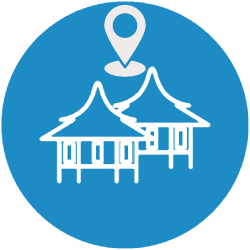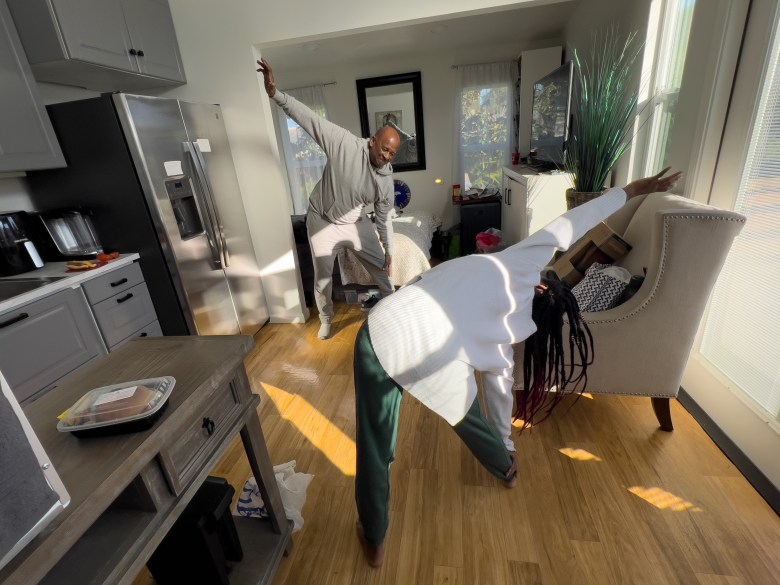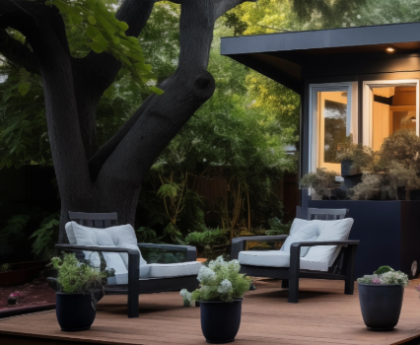Toast on a napkin, a cluster of pill bottles, extra reading glasses, a candy bowl full of cough drops. These are the traces of life found in the dwelling of someone in their senior years.
Someone’s parents are cooking less, going to the doctor more and avoiding talk of the future. Gatherings of grown children start to feel more like meetings. They share fears about everything that might happen if mom and dad go on living in the old house with increasing disabilities. They brainstorm, they argue, they research options, which are few.
Residential assisted living facilities can cost around $7,000 a month. In-home health care providers are in extreme short supply. How can grown daughters and sons possibly manage to care for ailing parents in the same home where they are raising babies, building careers and searching for fleeting intimate moments?
One solution may lie in accessory dwelling units, or ADUs, which are playing a bigger role in the lives of seniors and their adult children in California. For decades, cities largely obstructed their development due to suburban codes and attitudes. In-law houses, garage buildouts, attic and basement additions are all increasing in numbers since the California Legislature passed over a dozen bills to encourage their production.
A 2017 law streamlined their permitting, and in 2020 the state required local governments to boost them. Homeowners could get help through city, county and state programs connecting to ADU designers. They could download architectural drawings that cleared local building codes. Grants of $40,000 to cover starter costs were offered by the state Housing Finance Agency through 2023, but they have not appeared in the 2024 budget.
Life expectancy in the United States has risen from 39.4 years in 1860 to 78.9 years in 2020. By 2050, 22% of the U.S. population is expected to be over age 65.
In the decades after WWII, children constituted up to 36% of the U.S. population. They grew up watching The Smothers Brothers and the Vietnam war on television. This generation of Americans, which has always thought of itself as “a new idea,” is now entering their 70s and 80s.
When they came of age in the 1960s, the spotlight of popular culture shifted from the ballrooms of Guy Lombardo to the love-ins of John Lennon. The artistic mood was future-thinking and utopian, which permanently changed social and political narratives. Baby boomers are more likely to own homes and have finance capital, and they may be more open to the alternative lifestyles that ADUs can offer.
Parents rent ADUs to grown children who want to start families but cannot afford to buy homes of their own. Seniors rent to tenants for extra income and have some flexibility in a fixed retirement budget, maybe travel. Grown children can build ADUs for parents, who can in turn help to reduce another spiraling cost – childcare.
Architectural critics point to other countries, where age-diverse neighborhoods have more safe places within walking distance, more opportunities for multi-generational engagement and more accessible buildings and streetscapes. The troubles of aging may not magically disappear with ADUs, but their ripple effects in architecture and urban planning could make cities more livable for everyone. Physical changes done well could ignite behavioral changes and create cities of longevity.
Whether or not these housing arrangements contribute to a longer life is hard to measure. A 2023 working paper published by the Hoover Institution showed that relief from financial anxiety can improve mental health, perhaps add years. Research from Stanford’s Center on Longevity indicates that loneliness and lack of a sense of purpose can subtract years.
For some Bay Area seniors, ADUs have reduced financial stress and social isolation.
Bob Grant, Dublin

Bakari Grant’s father Bob, 72, sat up straight when his 12-year-old granddaughter Naomi entered the room. She began talking about exercises. Perched at the foot of his bed, she spoke in a mature baritone, a voice beyond her years. Bob’s eyes brightened in recognition of an awakened spirit.
“Her voice is deep, just like her mother’s,” Bob Grant said.
In 2012, Bob was living in Las Vegas, where he moved to get a divorce from his wife. Then there was another woman. Then some business involving loans and dishonest men. Then the stroke.
“I didn’t know I had a stroke until years later,” he said. “I can guess it happened in 1979.” It happened in 2014.
In 1979, Bob and his wife were living in Oakland, raising five children. He worked as a lab tech for Chevron. His oldest child, Bisa, grew up to become an engineer. Bob’s ADU now stands in her backyard in the East Bay suburb of Dublin.
His youngest child, Bakari Grant, grew up to become a professional athlete, a wide receiver for the San Francisco 49ers. He studied interior architecture at UC Davis and knew enough about materials to build an ADU. Bakari would become the founder of WellNest, an ADU builder that specializes in fast, accessibly designed, affordable units for families in crisis, like his.
The family had previously lost a grandmother to mistreatment in a nursing home. So together, for less than $100,000, the siblings constructed the ADU from scratch in Bisa’s backyard while “Pops” recovered in the house. Connecting the ADU to the same water lines as the big house saved money, but city permits and electrical hookups cost another $15,000.
Transitioning Bob from a hospital in Las Vegas to an independent home in Dublin was a three-year family ordeal. But the work they put into solving that crisis was repurposed as a new business model in 2020.
“If you need an engineer, we’ll do that for you. If you need house cleaning, maintenance or any of those things, we will do that too,” Bakari said. “We’ve created a network of partnerships to do all that – estate planning, legal work, financial assistance. We pretty much run the gamut of anything in the senior space.”
“There’s a ton of programs in every county, but they are scattered, or people feel like they shouldn’t get it because they do have some income,” he said. “So, they feel guilty about it.”
WellNest employs a certified senior advisor, a credentialed professional who offers strategic advice for aging. A typical base package for a senior includes companionship service, cleaning, food preparation, transportation and laundry.
From a showroom warehouse in Dublin, they offer four ADU designs, ranging from the Express Unit priced at $150,000 to the two-bedroom custom unit for $240,000. They use paneled architecture, a semi-modular system with complete walls that can be carried through a backyard fence. Many of their clients are adult children, some holding babies, whose lives have been halted by a parent’s health crisis. To reduce decision-fatigue, there are just a few options for things like cabinets and tile.
Accessible interiors have enough safety features for a person with increasing disabilities to live independently for years. Levers, instead of doorknobs, are easier on arthritic hands. Walk-in showers and handrails come in all units.
“Our senior package is going to have things like grab bars, handheld showerheads that can be placed at adjustable heights. Laminate is more forgiving in a fall than stone. Soft-fall flooring to keep from breaking a hip,” said Bakari. “We consider how people of all abilities can use our space.”
Bob has improved since moving into the ADU from the main house in 2017. He has friends at the senior center, where Open Heart Kitchen provides free meals – Polynesian meatloaf on Tuesday, chicken parmesan on Thursday. He drives his car on short errands around the neighborhood, and he works out at the gym four times a week. On Friday his son-in-law takes him to IHOP.
Bob’s granddaughter Nina, whose voice brings him home, studies dance. She helps Bob with stretching. She counts to 10 as he follows her lead and aims for his toes.
“He feels like he’s in charge of his life again and he feels like he can make decisions for himself,” said Bakari. These daily multigenerational activities might be adding years to Bob’s life.
Regular interaction with young people leads older people to feel more valued, included, and appreciated. One 2011 study showed seniors who experienced multi-generational engagements had reduced instances of depression, improved self-esteem and reported enhanced subjective health.
The doctor tells Bob that his health is pretty good.
“But what do they know,” Bob said. “I feel pretty good. I have trouble remembering names, but it’s good. I see my daughter once a month. I see my grandkids almost daily. We have dinners together.”

The average lot in Dublin is about 6,000 square feet (about twice the area of a tennis court). It is typical of the suburban code used in most California developments, even in big cities. Los Angeles has embraced the ADU movement. The state reported 7,160 ADUs permitted in Los Angeles in 2022, compared to 662 in San Diego, the city with the next-highest total.
According to a study by New York University’s Furman Center, ADUs in both the Bay Area and Southern California tend to be in census tracts that have relatively low rents and are typically sited on parcels with good access to jobs.
“The single-family house is a family’s greatest asset, but it also can be their greatest liability,” said Bo Sundius, an ADU architect in Los Angeles. “And then it’s inherently inflexible because you can’t move out of it. It’s literally the roof over your head. So, it’s hard to renovate, hard to change, can’t move out. If you’re underwater, you’re stuck.”
Once an ADU arrives, underutilized backyards start teeming with possibility.
“Immediately people start thinking about their property as this long-term investment,” Sundius said. “They see it not as a house, but more like a compound with many uses. Mom is in it for three quarters of the year, then she visits another sibling for three months. Then you use it as your home office for a spell. Or it’s a little bit of storage and an outdoor shower. You need extra cash? You can rent it out. If you just want to legally convert your garage into a studio so you can have your midlife-crisis-garage-band-dream-come-true, the ADU can do that.”
“One of the biggest problems with single-family zoning is that it’s a very rigid kind of code,” said architectural writer Christopher Hawthorne. “It’s sort of all or nothing, single family house or bust, without a lot of options for seniors who would like to stay in their immediate neighborhood. They need opportunities to downsize to smaller units.”
Hawthorne worked 14 years as the architectural critic for the Los Angeles Times. He left the paper in 2018 to join the mayor’s office as the city’s first chief design officer, where he worked for four years before joining the faculty at Yale University. When he arrived at the mayor’s office, he said, nearly 20% of all new permitted residential units were ADUs, with that number likely reaching over 25% today.
To propel the city’s enthusiasm for ADUs, Hawthorne called a national competition for architects to design ADUs that could be pre-approved through the Department of Building and Public Safety, which covered the bulk of the required codes. Through a city website, people could connect to architects and use their plans. The city eventually offered a set of drawings for free.
L.A. was once age-friendly, according to Hawthorne. In the late 19th and early 20th century, it had an excellent public transit system, for example.
“We had a really rich tradition of innovative multi-family housing, particularly small-scale apartment buildings, starting with courtyard apartment bungalow courts and other complexes wrapping around gardens,” he said.
After World War II, due to changes in federal housing and transportation policies, demographic change and some local policy shifts, Los Angeles became synonymous with freeways, single family neighborhoods and privatized backyards.
With ADUs, seniors can stay in their communities and live on the same piece of property, Hawthorne said. They can even move to the smaller ADU and rent out the main house, maybe allow their children to move into the larger house while they’re building a family.
Carol Nemiro, Castro Valley
Carol Nemiro, age 74, earns a teacher’s pension from Hollister Public School District and describes her economic status as lower middle class. She lives in a one-bedroom ADU in her son’s backyard in Castro Valley. Big windows face a courtyard where grandchildren ride trikes.
“I had a lot of friends in Hollister. It was hard to leave them,” Carol said. “It’s hard to see them now because most people my age don’t like to drive a lot.”
Her roommates live in four cages that frame the living room. They are two macaws, 8-year-old Tapestry and 17-year-old Hearsay. Then there is Lightning, an 18-year-old cockatoo, and Irony, a 12-year-old African gray parrot who talks to her when she’s on the phone with someone else. Carol’s birds are clearly the souls with whom she is spanning time. They have been with her through it all.
Her younger son died in a car crash in 2017, the same year her first grandchild was born. The following two years, her children’s father died and then her second husband. She and her second husband were great travelers. They once flew to Venice, Italy, and bought exotic glass birds.
Carol was denied her husband’s Social Security because of her teacher’s pension, and she began to accumulate debt. She contracted a melanoma in 2020. Immunotherapy damaged her lungs. She was alone in the four-bedroom family house surrounded by the memorabilia of a full life. That old house, where she once hosted parties where everyone and the dog ended up in the pool, had to go. It sold at the market peak for $765,000.
“I am still getting rid of that stuff,” Carol spoke from her new ADU. “It was hard going through it all. I filled two dumpsters. I had a garage sale. You know, people want stuff for nothing. A lot of it was stuff I hated to get rid of. They want to pay you $2 for it.”
After paying off the mortgage, Carol had $225,000 to invest in a new home. Her son, Brandon Kemp, 47, was a paralegal and good at research. He started to piece together a vision.
“November 2021 is when things took off,” Brandon said. He got $40,000 from the California Housing Finance Agency to cover pre-development costs. They found Hello Housing, an ADU developer, and started to design and build.
To finance it, Brandon took out a $125,000 line of credit on his house, which his mom is paying back like rent for $1,500 a month. The ADU was a $300,000 investment, but Brandon said his property, which he purchased in 2017 for $665,000, is now worth $1.2 million.
“It’s perfect for me, it’s a relief to get rid of the big house,” Carol said. “There’s not a lot of cleaning here. It’s easy to take care of.” She recently learned from her doctor that her melanoma is back. “It’s a comfort to have them nearby, with health issues or anything.”
The 2020 change in the California Health and Safety Code mandated that all cities and counties develop a plan that incentivizes and promotes the creation of ADUs. This spawned a wave of businesses that specifically enabled ADUs – architects, developers and non-profits. They connected homeowners to public resources, walked them through permitting and got the building done. Sometimes they expanded their menu to help guide clients all the way through their transition into a new life.
“What makes us different is that we are a full white-glove service, meaning if you need services, we’ll get it for you,” WellNest’s Bakari Grant said.

Spring Verity, Orinda
“My daughter had just given birth to her second child, and she could not afford to live in Oakland,” said Spring Verity, 83, from her one-bedroom ADU in Orinda, where every room was adorned with floral prints and patterns. “It was just after the banks had made that ridiculous mess and everybody’s house had dropped in value, so they had no equity.”
Spring’s house is sited in a parallel relationship to her daughter’s, not behind it. They sit balanced across an eastern slope and face the morning. In the courtyard between their homes is a sheltered dining table, autumn-blooming azaleas and a fallow garden. The outdoor bridge creates a third space, making the whole arrangement feel like a world within a world.
“We see some lovely hawks and we have deer, a lot of raccoons and skunks,” Spring said in an English accent. “And we have a cougar who’s decided recently to take up his residence here, which is rather tiresome because he wants to eat the chickens.”
Moving to the property in Orinda brought back memories of her childhood in England, close to nature.
“The last part of my childhood we lived in Henley-on-Thames,” she said holding up her iPhone to show a photograph someone had recently sent her of the same house today. “It was a house by the river. We had ponies, and we were about a mile from the Henley. We could walk along the towpath to the grocery or to go rowing and boating.”
Spring was a 23-year-old bride when she moved to Chicago in 1963. Her first husband, the father of her three children, was studying to become a doctor. His education brought them to Boston, then California in 1971.
“Back in those days, you know, if you wanted to go to Yosemite, you didn’t have to have a reservation or anything,” she said. “You drove in, you chose your campground, and you settled yourself down there with very few people around.”
After divorcing her first husband, she was working as a student counselor at UCLA when she met and married a geology professor, John, in 1989.
They were living in Pacific Palisades in 2004 when she nursed John through a losing battle with cancer. She did not tell him about the lump in the breast. Timing for a mastectomy is never good, but she managed through with the help of a sister.
The Pacific Palisades house sold high, for $1.25 million, which rendered a handy down payment for a new life with her grandchildren.
In 2010, she suggested to her daughter that they pool their resources. They purchased just under an acre of land with two structures on it for $980,000 and started working with the ADU developer New Avenue Inc. There was a larger home for the family, but the cottage had no foundation. It was full of rats and had to be torn down and rebuilt. Her one-bedroom ADU cost $230,000. Today, she lives on $6,000 a month, which pays for a cleaner and other needs.
“I made the down payment, but they took on the mortgage,” she said. By the time they all moved to the new place, her daughter and son-in-law had full-time jobs and two young sons.
“I could help with babysitting and chauffeuring,” she said. “Gabe was just a baby when we came. He was just one. And Toby was five. It was lovely.”
Having such an important role in her daughter’s family may have given Spring some additional years. A 2020 study published by Preventative Medicine shows evidence that a higher sense of purpose in life is associated with lower risk of chronic conditions and premature mortality. People with purpose might have more incentive to do the time-consuming and difficult activities of health screenings and exercise regimens, because sustaining better health might help them meet their purpose.
Alternatively, the health risks of loneliness and social isolation can increase a person’s risk of premature death from all causes, according to the U.S. Centers for Disease Control and Prevention. Social isolation was associated with about a 50% increased risk of dementia, 29% increased risk of heart disease and a 32% increased risk of stroke.
“When I moved up here, I didn’t know anybody. And it’s really difficult to get to know people when you’re my age,” she said. “When you’re younger, you have children, and you take them to the park and you meet people. Or you’re working and you meet people and so on. But it’s very difficult when you’re retired to meet anybody.”
Spring said the COVID-19 pandemic increased her isolation. No more mahjong club. No more volunteering at the Tilden Park Botanical Garden. As the grandkids became teenagers, babysitting tapered off.
“Toby’s started college now, so we miss him very much,” she said.
ADUs, of course, cannot eliminate the encroachments of age. Health issues limit Spring’s ability to go out and she easily tires.
“I seem to be getting weaker all the time, and it’s getting harder and harder to do all the simple things. I go down and take care of the chickens every day, and that’s pretty much my exercise.”
But she’s taken up knitting and likes to read. She sees her daughter daily and comes over for dinner sometimes. Overall, Spring said, her spirits are good.
“I’m very happy. I’m very content.”
Editor’s note: Story by Ruth Dusseault of Bay City News Service




